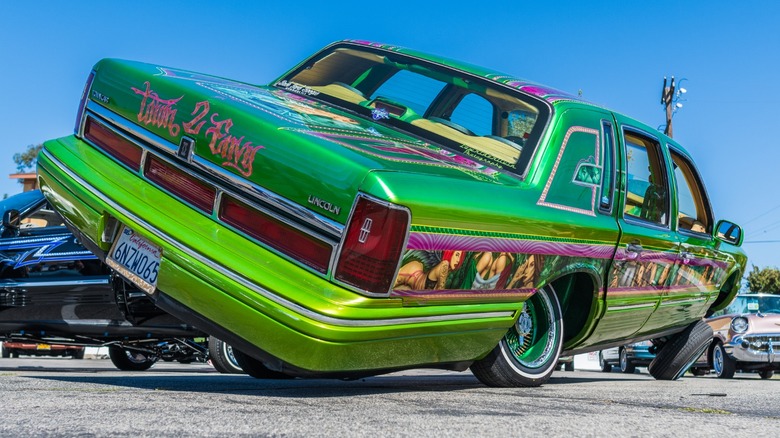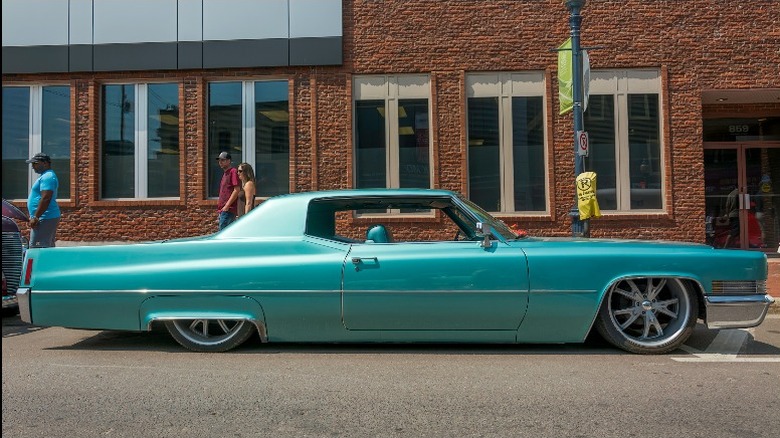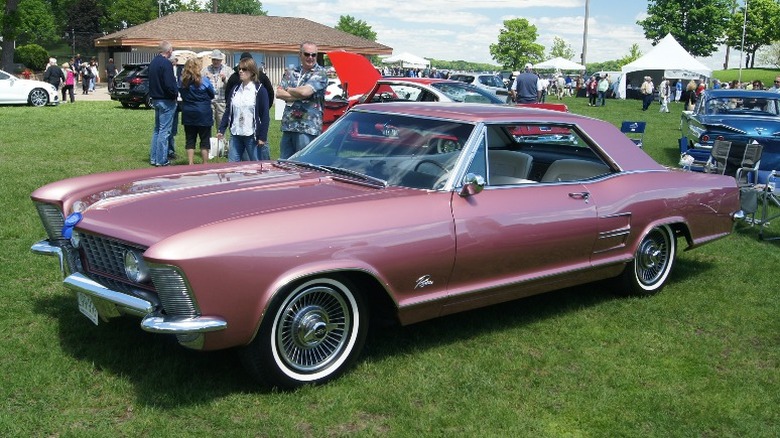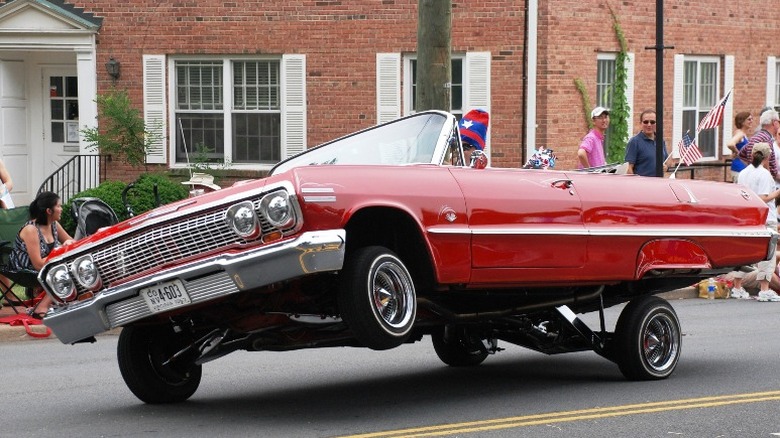

12 Cars That Make Awesome Lowriders
source link: https://www.slashgear.com/1158104/12-cars-that-make-awesome-lowriders/
Go to the source link to view the article. You can view the picture content, updated content and better typesetting reading experience. If the link is broken, please click the button below to view the snapshot at that time.

12 Cars That Make Awesome Lowriders

Off-road vehicle owners brag about how high their lift kits raise their bodies off the ground. Owners refer to approach, departure, and break-over angles that allow them to climb over almost any off-road obstacle. Lowriders, on the other hand, measure their ground clearance in centimeters (very few). Owners tout cruising "low and slow" and bouncing high in cars fitted with hydraulic systems or air-ride suspensions.
After World War II, Mexican American veterans began to customize their vehicles in a manner distinguished from the hot rod style that swept the country (via Smithsonian Magazine). They modified the engines, painted extravagant exteriors, and in some cases added weights in the back to lower the bodies
Today, lowriders boasting brightly colored paint jobs and bouncy hydraulics are often seen on the streets of Los Angeles. However, the style has also spread across the U.S. to Japan — most notably in Tokyo and Nagoya — as well as São Paulo, Brazil, in the form of low-cost lowrider bikes. Lowrider auto tuners often select Chevrolets for their abundant supply, the ease of modifying the General Motors X-frame used on cars built from 1957 to 1964, and the abundant body surface area available for displaying artwork. Here are 12 popular examples.
1964 Chevy Impala SS Coupe
Often referred to as the "64," the Chevrolet Impala SS might be the best representative of the lowrider culture. It gained popularity among lowrider tuners for its long low profile, clean shape, and lowered stance, making a conversion achievable with minimal modifications. The popular vehicle was even NBA star Shaquille O'Neal's choice when he started his lowrider restoration project (via Motor Trend).
When Chevrolet introduced the Impala in 1964, the automaker offered the car in several configurations including the two-door hardtop sport coupe, convertible, and four-door station wagon (via Chevy Hardcore). Engine options were the fuel-efficient 230 cubic-inch Turbo Thrift producing 140 horsepower, a 283-cubic-inch small-block V8 generating 195 horsepower, and the 327-cubic-inch small-blocks producing either 250 or 300 horsepower. Chevy also offered the famous big block 409 cubic-inch V8 producing either 340, 400, or 425 horsepower. The 327 version of the "64" cranking out 300 horsepower accelerates to 60 mph in 6.9 seconds and reaches the quarter mile in 15.5 seconds on its way to a top speed of 124 mph (via Automobile Catalog).
The 1964 Chevy Impala, Gypsy Rose, recently on display at the Petersen Museum in Los Angeles, is an example of a "low key" lowrider conversion (via Motor Trend), seen cruising Whittier Boulevard in Los Angeles during the opening credits of the TV sitcom "Chico and the Man."
[Featured image by Cars Down Under via Wikimedia Commons | Cropped and scaled | CC BY-SA 2.0]
1957 Chevrolet Bel Air
The 1957 Chevrolet Bel Air is an American classic. With its stylish tail fins and powerful V8 engine, it has been the choice of hot-rodders and muscle car enthusiasts for years, but the Chevy is also a favorite among lowrider fans. Chevrolet offered the 1957 model in three variations with the Bel Air as the top-tier trim, available as a two-door and four-door sedan, convertible, and four-door wagon. Besides the distinctive tail fins, the '57 Bel Air features twin "rockets" on the hood replacing the single jet that adorn the hoods of 1955 and 1956 Bel Airs (via Trust Auto).
In the early 1950s, Chevrolet equipped its full-sized cars with inline six-cylinder engines or the 265-cubic-inch V8. But in 1957, the automaker introduced the optional) 283-cubic-inch Super Turbo-Fire V8. The engine featured the Ramjet state-of-the-art fuel injection system, making the Bel Air the first production V8 passenger car with the technology (via Automobile Catalog). The 283 V8 engine (from Corvette) produced 270 horsepower and 285 ft-lb of torque. The 2-door hardtop coupe with a three-speed manual transmission accelerated to 60 mph in an impressive 7.5 seconds and reached the quarter mile time in 15.7 seconds.
[Featured image by Accord14 via Wikimedia Commons | Cropped and scaled | CC BY-SA 2.0]
1964 Buick Riviera
Hemmings called the 1963 Buick Riviera, "one of the most beautifully designed vehicles ever." The 1964 model was equally as graceful, maintaining the same body style before a remodel in 1965. Sales in 1964 confirmed the design's success, with more than 37,600 vehicles sold, nearly equal to the 1963 figures. Only competition from the Chevrolet Impala, Oldsmobile Delta 88, Pontiac's Grand Prix, and Bonneville prevented record Riviera sales in 1964.
The Buick offers the lowrider enthusiast an upscale vehicle for conversion. The luxury car came from the factory with a plush stylish interior, making an upgrade straightforward with merely the addition of style embellishments and a custom sound system. According to Top Speed, lowrider tuners acknowledged the Riviera's lighter weight and performance capabilities as two features that made the vehicle a desirable lowrider option. Buick equipped the model with the same engine as other models, but the lighter weight gave it better performance. The uniquely pointed front end distinguished the Riviera from other lowriders.
The 1964 Buick Riviera with a 2-door hardtop coupe body came with a 425-cubic-inch V8 coupled to a three-speed automatic that generated 315 horsepower and 465 lb-ft of torque. The car accelerated to 60 mph in a respectable 8.2 seconds, reached the quarter mile in 16 seconds, and achieved a top speed of 126 mph (via Automobile Catalog).
[Featured image by Greg Gjerdingen via Wikimedia Commons | Cropped and scaled | CC BY-SA 2.0]
1994 Cadillac Fleetwood
The 1993-1996 Fleetwood models marked the end of the era of full-size, big-bodied rear-wheel-drive Cadillac sedans. The dignified Brougham, with a 5.7-liter LT1 V8 borrowed from the Corvette, was the most imposing and powerful Fleetwood in the line. Despite weighing 4,506 pounds (via Automobile Catalog), the Fleetwood accelerated to 60 mph in 8.2 seconds and achieved a top speed of 142 mph.
However, for the lowrider enthusiast, acceleration and top speed are less important than style and comfort. The Fleetwood Brougham features more than ample room for six passengers, making the interior the most spacious on the market in 1994. The Brougham is typically equipped with power everything: windows, locks, steering, mirrors, and brakes. A Taupe leather front split bench seat with a fold-down center armrest provides the ultimate comfort for the driver and passengers.
Lowrider tuners often install suspension systems in their cars, giving them the capability to perform maneuvers such as independently lowering or lifting the sides, front or rear, and even ride on just three wheels. Hydraulic systems or air ride suspensions are usually used to perform tricks and to achieve the bouncing effect (via Wheels Joint). Both systems can perform similar functions with a few differences. Air ride systems provide better ride quality, and the parts are cheaper. Cars equipped with hydraulic suspension have a quicker response time, making them the preferred configuration for hopping and jumping.
[Featured image by Joe Mabel via Wikimedia Commons | Cropped and scaled | CC BY-SA 4.0]
1962 Chevrolet Impala
First introduced in 1958, Chevrolet manufactured the Impala on and off for more than six decades. The full-size sedan was Chevrolet's most expensive passenger car through 1965, setting the standard for comfort and value. The 1962 Impala had only a few body style modifications over the previous year, but the most significant was the ribbed roof line, which gave it a "convertible top" appearance. The changed look became popular with buyers and today is considered part of the Impala's appeal to collectors.
Under the hood of the 1962 Impala is where Chevrolet made the most significant changes. The standard engine options carried over a 235-cubic-inch inline six-cylinder engine producing 135 horsepower and the 283-cubic-inch small-block V8 with a two-barrel carburetor generating 170 horsepower. However, Chevy also introduced the all-new 327-cubic-inch small-block in 250 horsepower and 300 horsepower varieties (via Chevy Hardcore).
At the high end of the powertrain options, Chevrolet discontinued the array of 348-cubic-inch engines that were available in 1961 and replaced them with the 409 cubic-inch engine. The new engine came with an optional dual four-barrel carburetor generating an impressive (for the time) 409 horsepower, giving it legendary status among Chevrolets. The Beach Boys even wrote a song about it.
[Featured image by TKOIII via Wikimedia Commons | Cropped and scaled | CC BY-SA 4.0]
1970 Cadillac Coupe DeVille

The 1970 Cadillac Coupe DeVille was America's favorite luxury car of the time. Available only with two doors, the hardtop measured 225 inches in length and 79.8 inches wide. Often referred to as a "land yacht,'" the 129.5-inch wheelbase and body-on-frame construction including a boxed perimeter provided the Coupe deVille's rigid backbone. The front suspension featured an integral steering knuckle for prolonged life, while helical coil springs assisted both upper and lower control arms. Road shock and noise were isolated from the silent cabin with rubber-mounted strut rods and bushings.
The outstanding ride quality was complimented by the luxurious interior handmade by Fleetwood, which was spacious enough to sit up to six passengers. Cadillac offered buyers a choice of 10 separate colors to match the exterior and included automatic climate control, a hazard warning system, AM/FM radio system, a non-glare rear-view mirror, and an electric clock.
Cadillac powered the Coupe DeVille with a naturally aspirated 7.7-liter, overhead valve 90-degree V8. The mill produced 375 bhp at 4,400 rpm, and a maximum torque of 525 lb-ft at 3000 rpm (via Carfolio), sending power to the rear wheels via three-speed TH-400 automatic transmission. Although the DeVille weighed a substantial 4,784 pounds, it accelerated to 60 mph in 7.8 seconds, reached the quarter mile in 15.7 seconds, and achieved a top speed of 131 mph (via Automobile Catalog). Cadillac built 238,745 vehicles for the 1970 model year, of which 181,719 were Coupe and Sedan DeVille models (via Notorious Luxury).
1963 Chevrolet Impala Convertible
In 1962, General Motors introduced the convertible hardtop body style across most corporate product lines including Chevrolet, Pontiac, Buick, and Oldsmobile divisions for both full-size and compact cars. The design's popularity contributed to a banner year for Chevrolet, leading all American automakers with 2,061,677 passenger vehicles produced. The convertible was discontinued in 1964. However, years later the design became a popular choice for lowrider tuners. From a 230-cubic-inch straight-six to a dual-quad 409-cubic-inch V-8, the 1963 Impala provided an ample choice of powerplants and an extensive options list (via Automobile Catalog).
Chevrolet supported the engines with a robust frame and suspension system that would appeal to those looking for the "low and slow" ride. The automaker built the box-section X-frame with welded steel measuring 119 inches. Heavy-duty coil springs, unequal-length upper and lower control arms, shock absorbers, and an anti-roll bar made up the front suspension. The 1963 Impala Convertible featured a solid rear axle positioned with a single upper arm, two lower control arms, and a lateral control bar ("Panhard bar"). Rear-mounted heavy-duty coil springs absorbed shocks from road imperfections (via Hemmings).
[Featured image by Jarek Tuszyński via Wikimedia Commons | Cropped and scaled | CC BY-SA 3.0]
1962 Pontiac Catalina
The Catalina (1950 to 1981) represented the high-performance offering in Pontiac's line of full-size coupes and convertibles. The lightest and least expensive, it featured Super Duty engines and other modifications, making it a favorite among performance enthusiasts (via Motor Trend). For the 1962 models, Pontiac made significant revisions to the 1961 design including more rounded body contours and revised rooflines on two-door hardtops.
At the low end of the performance curve, Pontiac offered the Catalina Sports Coupe 389 Trophy V8E Economy with a three-speed automatic. The 2-door coupe produced 230 horsepower and 380 lb-ft of torque (via Automobile Catalog). The Catalina produced a mediocre performance, accelerating from 0 to 60 mph in an estimated 11.7 seconds, reaching the quarter mile in 18.7 seconds, and could achieve a max speed of 117 mph. The Catalina accelerated to 60 mph in an estimated 6.3 seconds, reached the quarter mile in 14.9 seconds, and achieved a top speed of 139 mph.
The Catalina was a groundbreaking design when Pontiac began looking for ways to improve performance. The automaker offered aluminum bumpers and lightweight frames with drilled holes ("Swiss cheese" frames in the 1963 models) to reduce the weight, as a performance option on the 421-cubic-inch Super Duty V8. Pontiac learned lessons with the Catalina that eventually influenced the design of one of the famous 1964 Pontiac GTO.
[Featured image by nakhon100 via Wikimedia Commons | Cropped and scaled | CC BY-SA 2.0]
1980 Lincoln Continental Mark VI
The full-size luxury Lincoln Continental Mark VI was short-lived (1980 to 1983) but served as Ford Motor Company's flagship model, rated even higher than Lincoln Town Car during its production years. The fifth generation of the Mark series was the first model line to experience downsizing (via Volocars). Ford introduced the Mark VI with a host of new tech features to complement the higher fuel efficiency, including electronic fuel injection, a computer-controlled engine management system, a digital instrument panel, and a trip computer.
Ford's emphasis on fuel economy, ride comfort, and luxury for the down-sized Mark VI meant a lower priority for performance. Lincoln fitted the two-door coupe with a 5.0-liter V8 engine, producing 129 horsepower and 231 lb-ft of torque mated to a four-speed automatic (via Automobile Catalog). The car accelerated to 60 mph in a lethargic 13.7 seconds and reached the quarter mile in 19.5 seconds on its way to a top speed of 102 mph.
Buyers could also choose to purchase a 5.8-liter Windsor V8 with 140 horsepower and 265 lb-ft of torque. However, the performance improved only slightly. It accelerated to 60 mph in an estimated 13 seconds, reached the quarter mile in 19.3 seconds, and achieved a top speed of 105 mph. Fuel consumption for both cars was an estimated EPA combined rating of 19 mpg.
[Featured image by Jarek Tuszyński via Wikimedia Commons | Cropped and scaled | CC BY-SA 3.0]
1960 Ford Galaxie
Ford restyled its full-sized cars in 1960 emphasizing aerodynamics. The changes included a sloping hood, a windshield offering 30% more visibility, and a new grille featuring quad headlamps. Ford accented fender edges with a chrome band and the signature "Jet Tube" taillight round lenses were replaced with elliptical-shaped lenses.
All full-sized Fords from 1960 to 1964 used a standard suspension, consisting of an independent front suspension with 4-inch coil springs over tube shocks, ball joints. In the eight-cylinder models, the live-axle rear suspensions employed tube shocks and longitudinal semi-elliptical leaf springs. The eight-cylinder high-performance versions were fitted with heavy-duty springs and shock absorbers, and a front anti-roll bar (via Hemmings).
The basic trim included rubber floor mats while an upgraded version came with cloth and vinyl (no leather) seats and full carpeting. Ford offered the base model 1960 Galaxie with a 223-cubic-inch straight-six engine. Fitted with a one-barrel carburetor, the engine produced 145 horsepower at 4,000 rpm and 206 lb-ft. of torque at 2,200 rpm. The base V8 displaced 292 cubic inches, supported a two-barrel Holley carburetor, and generated 185 horsepower at 4,200 rpm and 292 lb-ft. of torque at 2,200 rpm (via Automobile Catalog).
[Featured image by Morven via Wikimedia Commons | Cropped and scaled | CC BY-SA 3.0]
1983 Cadillac Coupe de Ville
The 1983 Cadillac Coupe de Ville reaches 221 inches in length. While it is not the longest Cadillac ever made (that distinction belongs to the 1930 Cadillac Fleetwood Sixty Special Brougham d'Elegance measuring 247 inches), it is, perhaps, an ideal length for a lowrider. Cadillac made only a few minor changes to the DeVille, Fleetwood coupe, and sedan body style for the 1983 model year. The characteristic grill, like the '82 version, featured narrow vertical bars separated into three rows. Cadillac created a bare upper horizontal bar when it moved the script to the side of the grille, making the '83 model easy to distinguish from the previous year's Coupe de Ville.
Cadillac offered the standard Coupe de Ville interior with a heather knit cloth and matching Dundee ribbed cloth inserts or a Saddle leather upgrade. The DeVille d'Elegance trim featured accent striping, a six-way power passenger seat, and opera lamps (via Amazing Classic Cars). For the 1983 model year, Cadillac bumped the power by 10 on the HT-4100 Digital Fuel Injected 4.1-liter V8 mated to a four-speed automatic. The engine generated 135 horsepower and 200 lb-ft of torque. Another vehicle adhering to the lowrider's motto, "low and slow," the Cadillac accelerated to 60 mph in an unhurried 13.1 seconds, reached the quarter mile after 19.1 seconds, and achieved a maximum speed of 105 mph (via Automobile Catalog).
[Featured image by Greg Gjerdingen via Wikimedia Commons | Cropped and scaled | CC BY-SA 2.0]
1963 Ford Thunderbird
Although the Ford Thunderbird began life in 1955 as a two-seater sport luxury vehicle, the 1958 T-bird with its new four-seat configuration signaled a change in the company's design direction. By 1960 the T-bird had become a big personal luxury car with little to distinguish it in performance or handling characteristics. Thunderbird production in 1960 nearly doubled the total sales in the 1955-1957 era (via Motor Trend).
The Ford 2-door hardtop Thunderbird coupe with Special 390 V8 fitted with a Holley 4-barrel coupled to a three-speed automatic produced 300 horsepower and 427 lb-ft of torque. There was sufficient power to accelerate the 4,195-pound vehicle from 0 to 60 mph in a respectable 8.7 seconds and reach the quarter mile time in 16.4 seconds. The Thunderbird achieved a maximum speed of 129 mph (via Automobile Catalog).
Future Thunderbirds might be headed for another change in design philosophy. As car manufacturers modify model offerings to feature electric vehicles, based on successful body styles of traditionally powered models, Ford may be considering an electric variation of the Thunderbird.
[Featured image by Morven via Wikimedia Commons | Cropped and scaled | CC BY-SA 3.0]
Recommend
About Joyk
Aggregate valuable and interesting links.
Joyk means Joy of geeK










